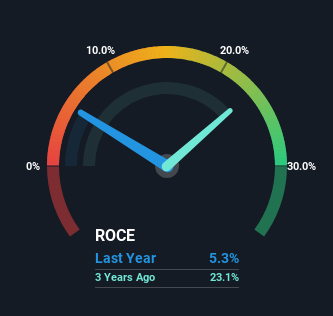- China
- /
- Marine and Shipping
- /
- SHSE:603162
The Returns On Capital At Fujian Highton Development (SHSE:603162) Don't Inspire Confidence
If we want to find a stock that could multiply over the long term, what are the underlying trends we should look for? Typically, we'll want to notice a trend of growing return on capital employed (ROCE) and alongside that, an expanding base of capital employed. Basically this means that a company has profitable initiatives that it can continue to reinvest in, which is a trait of a compounding machine. However, after investigating Fujian Highton Development (SHSE:603162), we don't think it's current trends fit the mold of a multi-bagger.
What Is Return On Capital Employed (ROCE)?
For those that aren't sure what ROCE is, it measures the amount of pre-tax profits a company can generate from the capital employed in its business. Analysts use this formula to calculate it for Fujian Highton Development:
Return on Capital Employed = Earnings Before Interest and Tax (EBIT) ÷ (Total Assets - Current Liabilities)
0.053 = CN¥239m ÷ (CN¥5.1b - CN¥593m) (Based on the trailing twelve months to June 2024).
So, Fujian Highton Development has an ROCE of 5.3%. In absolute terms, that's a low return and it also under-performs the Shipping industry average of 7.4%.
View our latest analysis for Fujian Highton Development

While the past is not representative of the future, it can be helpful to know how a company has performed historically, which is why we have this chart above. If you're interested in investigating Fujian Highton Development's past further, check out this free graph covering Fujian Highton Development's past earnings, revenue and cash flow.
What Can We Tell From Fujian Highton Development's ROCE Trend?
In terms of Fujian Highton Development's historical ROCE movements, the trend isn't fantastic. To be more specific, ROCE has fallen from 16% over the last five years. However, given capital employed and revenue have both increased it appears that the business is currently pursuing growth, at the consequence of short term returns. And if the increased capital generates additional returns, the business, and thus shareholders, will benefit in the long run.
On a related note, Fujian Highton Development has decreased its current liabilities to 12% of total assets. So we could link some of this to the decrease in ROCE. What's more, this can reduce some aspects of risk to the business because now the company's suppliers or short-term creditors are funding less of its operations. Some would claim this reduces the business' efficiency at generating ROCE since it is now funding more of the operations with its own money.
What We Can Learn From Fujian Highton Development's ROCE
While returns have fallen for Fujian Highton Development in recent times, we're encouraged to see that sales are growing and that the business is reinvesting in its operations. These growth trends haven't led to growth returns though, since the stock has fallen 32% over the last year. As a result, we'd recommend researching this stock further to uncover what other fundamentals of the business can show us.
Since virtually every company faces some risks, it's worth knowing what they are, and we've spotted 3 warning signs for Fujian Highton Development (of which 1 shouldn't be ignored!) that you should know about.
While Fujian Highton Development isn't earning the highest return, check out this free list of companies that are earning high returns on equity with solid balance sheets.
New: AI Stock Screener & Alerts
Our new AI Stock Screener scans the market every day to uncover opportunities.
• Dividend Powerhouses (3%+ Yield)
• Undervalued Small Caps with Insider Buying
• High growth Tech and AI Companies
Or build your own from over 50 metrics.
Have feedback on this article? Concerned about the content? Get in touch with us directly. Alternatively, email editorial-team (at) simplywallst.com.
This article by Simply Wall St is general in nature. We provide commentary based on historical data and analyst forecasts only using an unbiased methodology and our articles are not intended to be financial advice. It does not constitute a recommendation to buy or sell any stock, and does not take account of your objectives, or your financial situation. We aim to bring you long-term focused analysis driven by fundamental data. Note that our analysis may not factor in the latest price-sensitive company announcements or qualitative material. Simply Wall St has no position in any stocks mentioned.
About SHSE:603162
Fujian Highton Development
Engages in the coastal and international ocean dry bulk transportation business in China and internationally.
Flawless balance sheet with acceptable track record.
Market Insights
Community Narratives




